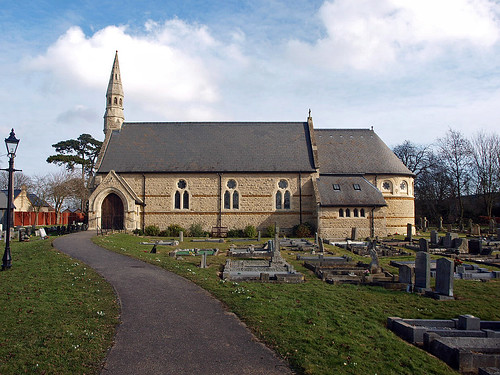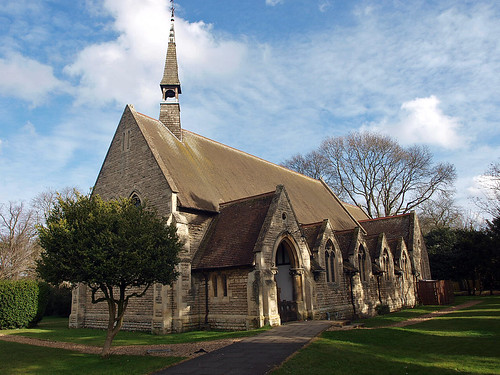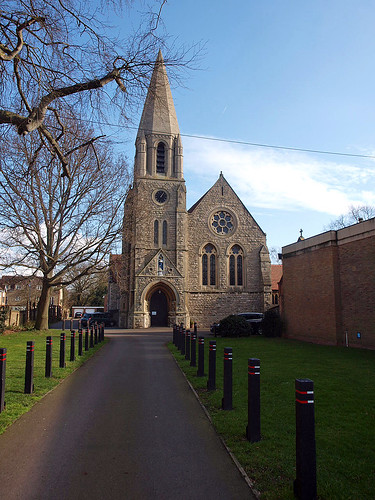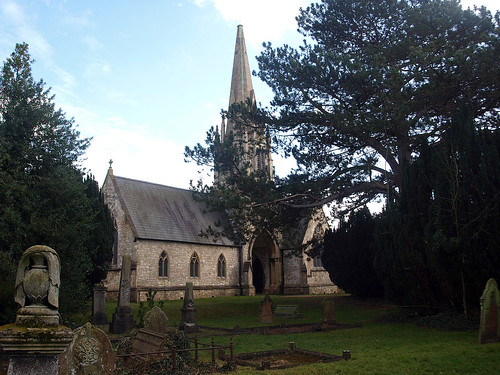ST JOHN. N of the Cemetery. 1872 by T. H. Wyatt. Rock-faced with transverse roofs to the bays of the aisle and a diagonally set bell-cote with timber spirelet.
ST MARY MAGDALENE, on the way to Westry. 1891 by Spiers (GR) Rock-faced, with apse and polygonal bell-cote.
ST PETER, High Street. 1880 by T. H. Wyatt. Rock-faced with NW spire of Cambridgeshire type. Straight E end, plate tracery, arcades on short circular piers with crocket-type capitals.
CEMETERY. The chapels and the spire between them, with a passage through are by W. Stephenson, 1867-8.
MARCH. Among the disappearing fens, the high ground crowned by Ely Cathedral is part of an archipelago of islands, on one of which stands this capital of the Isle. Till late last century it was a hamlet of Doddington; now it is a busy little market town and a railway junction, with a long straggling street and buildings befitting its grown-up importance. Three of the four parishes into which it has been divided have each a modern church, St Mary’s, St John's, and St Peter’s; but Old March, away from the stir of the oflicial capital, treasures the beautiful medieval church. A few dwellings gather round it, and a thatched farmhouse near by has 1658 on its chimney stack. A long avenue of venerable elms runs along the road which brings us to it, and at the foot of one of the trees is the square base of an old cross, carved with roses and shields of arms and set on a flight of steps.
The old church was built about the middle of the 14th century as a chapelry of Doddington, and given the rare dedication of St Wendreda, an obscure Saxon saint of whom little is known, but whose relics are said to have been taken in a golden shrine, at the request of King Ethelred, from here to Ely. Fine battlements adorn the walls of this church, except for the new gabled chancel. The parapets of the 15th century aisles have quatrefoil tracery, and a band of quatrefoils runs round the plinth of the aisles and the old south porch, which has big windows, stone seats, a gable cross, and a stoup. There are grotesque gargoyles, and by some of the windows are human and animal heads, one of a woman in horned headdress. The sanctus bell still rings in the bellcot on the eastern gable of the nave, which has a striking 15th century clerestory of nine windows on each side, richly patterned in flint and stone. Crowning it all is a fine tower of about 1400, from which soars a graceful spire with canopied lights. The tower stands on two open arches with a vaulted passage between them, preserving a right-of-way existing here before the tower was built.
The medieval windows which light the fine interior are set in walls carved with arches at the top of which are human figures and angels. Lofty arcades divide the nave and aisles, the north aisle 600 years old and the south side 500. Exceedingly lofty, dwarfing the arcades, are the arches of the tower and chancel, the tower arch having a good Jacobean ringer’s gallery halfway up.
The great glory of the church is the magnificent double hammerbeam roof, whose equal it would be hard to find. It is all richly carved by 15th century craftsmen, with an amazing array of angels hovering over the nave from the arches and the hammerbeams, as well as from the corbels, which support saints standing in niches between the clerestory windows. There are nearly 200 angels in this heavenly host, all with outstretched wings, some with musical instruments, some with shields, and others with emblems of the Passion.
It is thought that William Dredenian, who died in 1503, gave this lovely roof, and two small brass portraits in the floor of the nave, now very worn, are believed to be of him and his wife. Under the tower is another brass with 16th century kneeling figures of Antony Hansart in armour and tabard, his feet gone, his wife in kennel headdress and girdled gown, their small daughter without a head. Below them is their shield, and above them is a striking and unusual Annunciation showing the Madonna kneeling at a desk, the Archangel Gabriel kneeling before her, and a vase of lilies between them.
There is an ancient font, and a modern pulpit with a vine border and figures of the Good Shepherd and the Four Evangelists. A richly coloured window of the south aisle has St Michael, St Etheldreda with her abbey at her feet, and St Wendreda holding her church. The most striking of the windows has a setting of seas and mountains, and a child with a bunch of flowers looking into the sky, where Our Lord is receiving two men at the gate of Heaven. A stone by the chancel door marks the grave of John Wyldboar, who lived through the hundred years from the middle of the reign of Charles Stuart.
Flickr.
The old church was built about the middle of the 14th century as a chapelry of Doddington, and given the rare dedication of St Wendreda, an obscure Saxon saint of whom little is known, but whose relics are said to have been taken in a golden shrine, at the request of King Ethelred, from here to Ely. Fine battlements adorn the walls of this church, except for the new gabled chancel. The parapets of the 15th century aisles have quatrefoil tracery, and a band of quatrefoils runs round the plinth of the aisles and the old south porch, which has big windows, stone seats, a gable cross, and a stoup. There are grotesque gargoyles, and by some of the windows are human and animal heads, one of a woman in horned headdress. The sanctus bell still rings in the bellcot on the eastern gable of the nave, which has a striking 15th century clerestory of nine windows on each side, richly patterned in flint and stone. Crowning it all is a fine tower of about 1400, from which soars a graceful spire with canopied lights. The tower stands on two open arches with a vaulted passage between them, preserving a right-of-way existing here before the tower was built.
The medieval windows which light the fine interior are set in walls carved with arches at the top of which are human figures and angels. Lofty arcades divide the nave and aisles, the north aisle 600 years old and the south side 500. Exceedingly lofty, dwarfing the arcades, are the arches of the tower and chancel, the tower arch having a good Jacobean ringer’s gallery halfway up.
The great glory of the church is the magnificent double hammerbeam roof, whose equal it would be hard to find. It is all richly carved by 15th century craftsmen, with an amazing array of angels hovering over the nave from the arches and the hammerbeams, as well as from the corbels, which support saints standing in niches between the clerestory windows. There are nearly 200 angels in this heavenly host, all with outstretched wings, some with musical instruments, some with shields, and others with emblems of the Passion.
It is thought that William Dredenian, who died in 1503, gave this lovely roof, and two small brass portraits in the floor of the nave, now very worn, are believed to be of him and his wife. Under the tower is another brass with 16th century kneeling figures of Antony Hansart in armour and tabard, his feet gone, his wife in kennel headdress and girdled gown, their small daughter without a head. Below them is their shield, and above them is a striking and unusual Annunciation showing the Madonna kneeling at a desk, the Archangel Gabriel kneeling before her, and a vase of lilies between them.
There is an ancient font, and a modern pulpit with a vine border and figures of the Good Shepherd and the Four Evangelists. A richly coloured window of the south aisle has St Michael, St Etheldreda with her abbey at her feet, and St Wendreda holding her church. The most striking of the windows has a setting of seas and mountains, and a child with a bunch of flowers looking into the sky, where Our Lord is receiving two men at the gate of Heaven. A stone by the chancel door marks the grave of John Wyldboar, who lived through the hundred years from the middle of the reign of Charles Stuart.
Flickr.




No comments:
Post a Comment